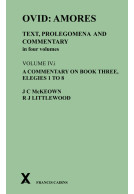Late Latin and Early Romance in Spain and Carolingian France (Hardback)
Imprint: Francis Cairns Publications
Illustrations: xii + 322 pages.
ISBN: 9780905205120
Published: 1st December 1982
Script Academic & Professional
Illustrations: xii + 322 pages.
ISBN: 9780905205120
Published: 1st December 1982
Script Academic & Professional
You'll be £35.00 closer to your next £10.00 credit when you purchase Late Latin and Early Romance in Spain and Carolingian France. What's this?
+£4.99 UK Delivery or free UK delivery if order is over £40
(click here for international delivery rates)
Order within the next 4 hours, 6 minutes to get your order processed the next working day!
Need a currency converter? Check XE.com for live rates
(click here for international delivery rates)
Order within the next 4 hours, 6 minutes to get your order processed the next working day!
Need a currency converter? Check XE.com for live rates
Late Latin and Early Romance presents a theory of the relationship between Latin and Romance during the period 400-1250. The central hypothesis is that what we now call 'Medieval Latin' was invented around 800 AD when Carolingian scholars standardised the pronunciation of liturgical texts, and that otherwise what was spoken was simply the local variety of Old French, Old Spanish, etc. Thus, the view generally held before the publication of this work, that 'Latin' and 'Romance' existed alongside each other in earlier centuries, is anachronistic. Before 800, Late Latin was Early Romance. This hypothesis is examined first from the viewpoint of historical linguistics, with particular attention paid to the idea of lexical diffusion (ch. 1), and then (ch. 2) through detailed study of pre-Carolingian texts. Chapter 3 deals with the impact in France of the introduction of standardised Latin by Carolingian scholars, and shows how the earliest texts written in the vernacular resulted from it. The final two chapters turn to the situation in Spain from the eighth to the thirteenth centuries. Ch. 4 suggests, on the evidence of a large variety of texts, that before 1080 the new Latin pronunciation (i.e. Medieval Latin) was not used; Ch. 5 charts the slow spread, as a result of Europeanising reforms, of a distinction between Latin and vernacular Romance between 1080 and 1250. There is an extensive bibliography and full indexes. Wright's controversial book presents a wide range of detailed evidence, with extensive quotation of relevant texts and documents. When it was published in 1982 it challenged established ideas in the fields of Romance linguistics and Medieval Latin. The collectively established facts are however explained better by his theory that Medieval Latin was a revolutionary innovation consequent upon liturgical reform, than by the view that it was a miraculous conservative survival that lasted unchanged for a millennium. Late Latin and Early Romance draws on philological, historical and literary evidence from the medieval period, and on historical linguistics, and is a seminal work in these areas of scholarship.
Other titles in Francis Cairns Publications...










